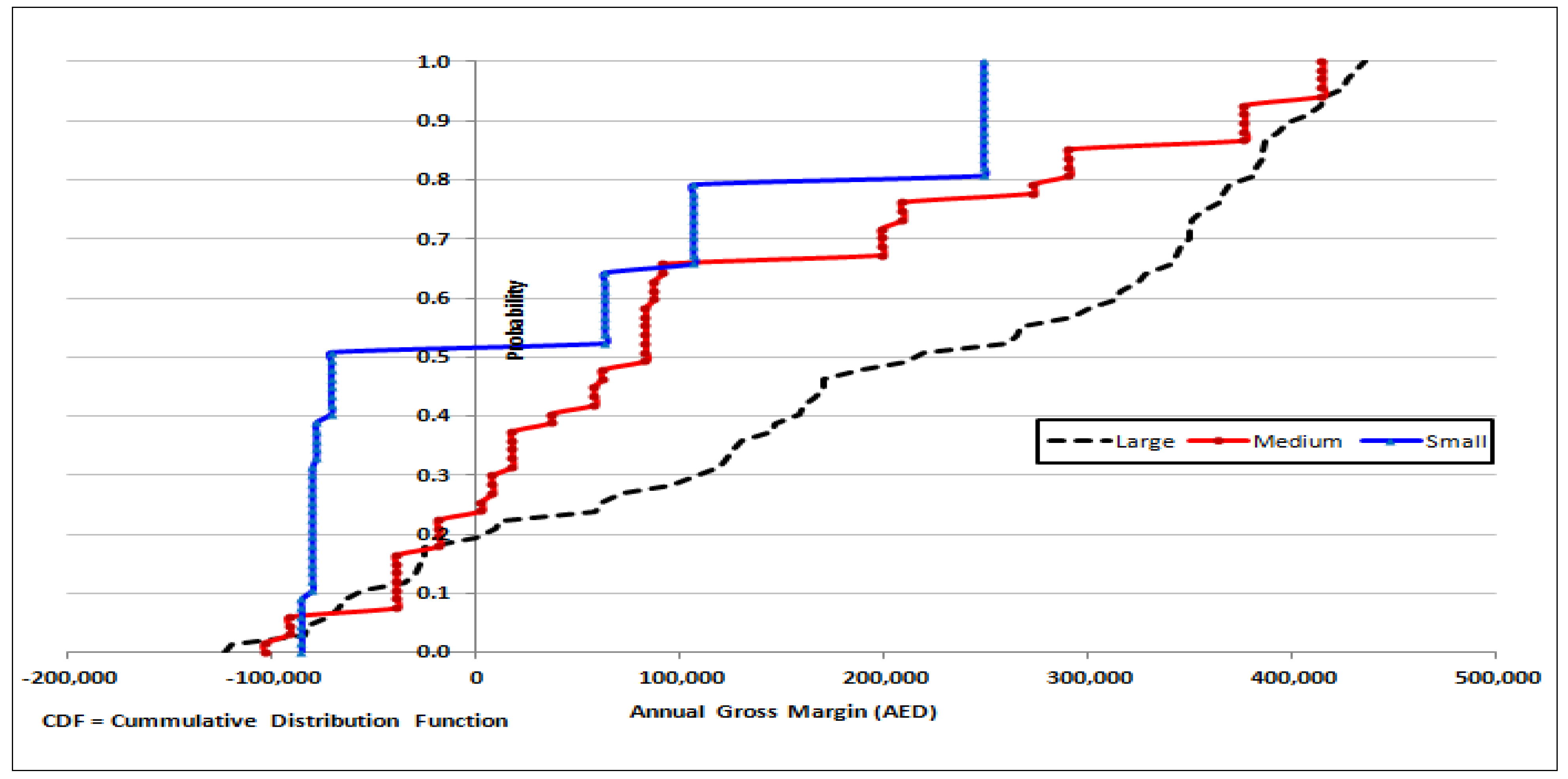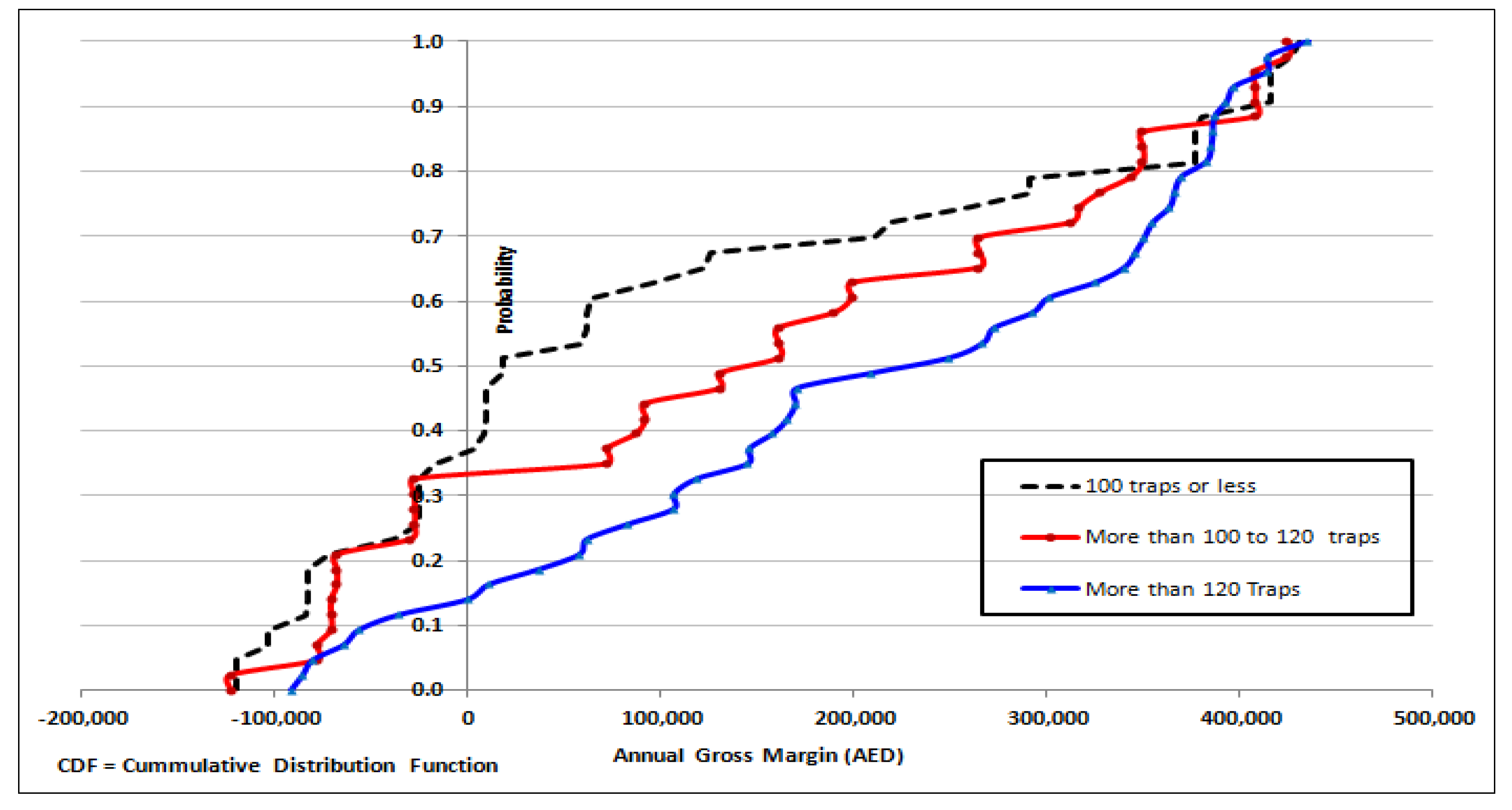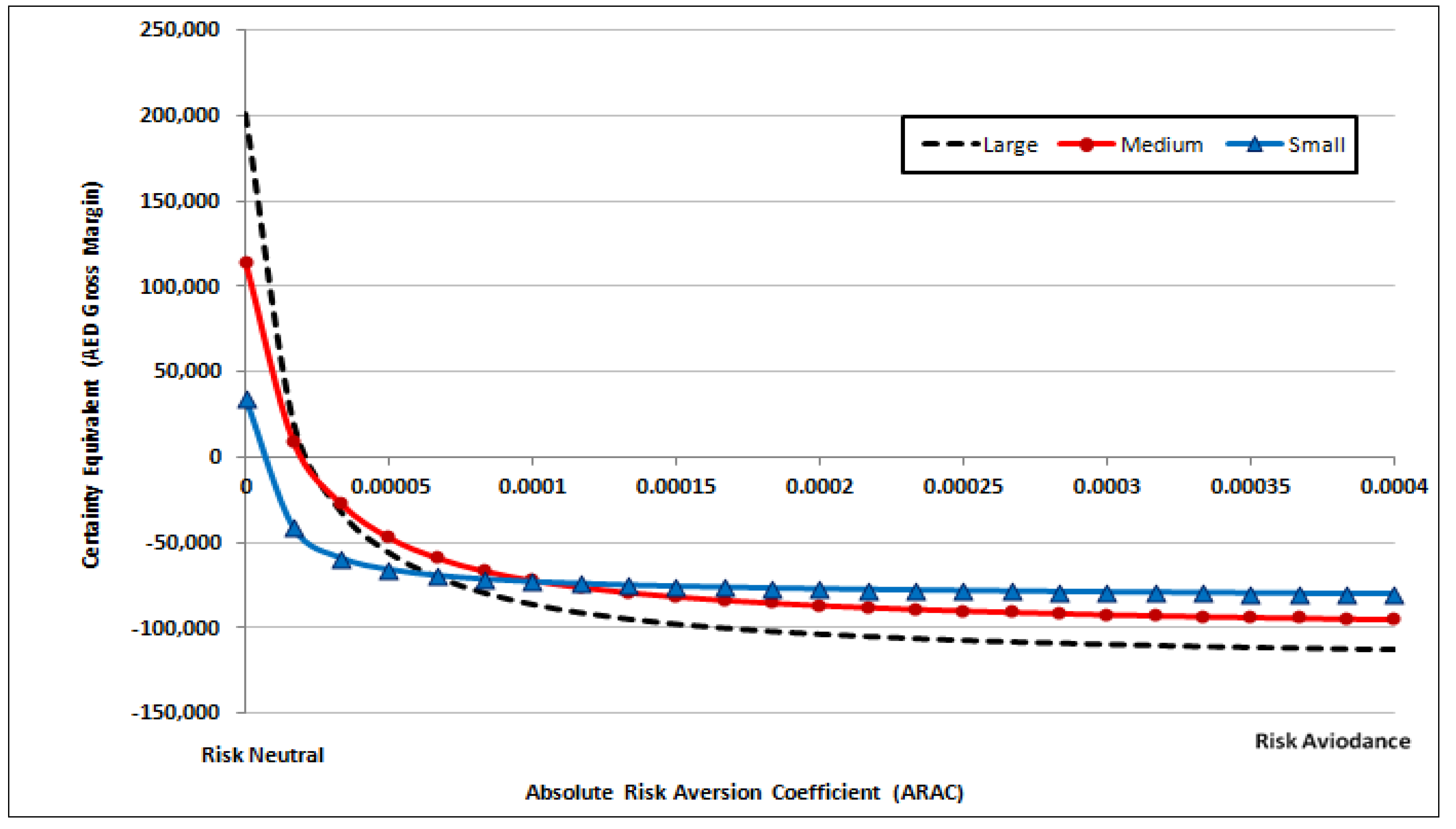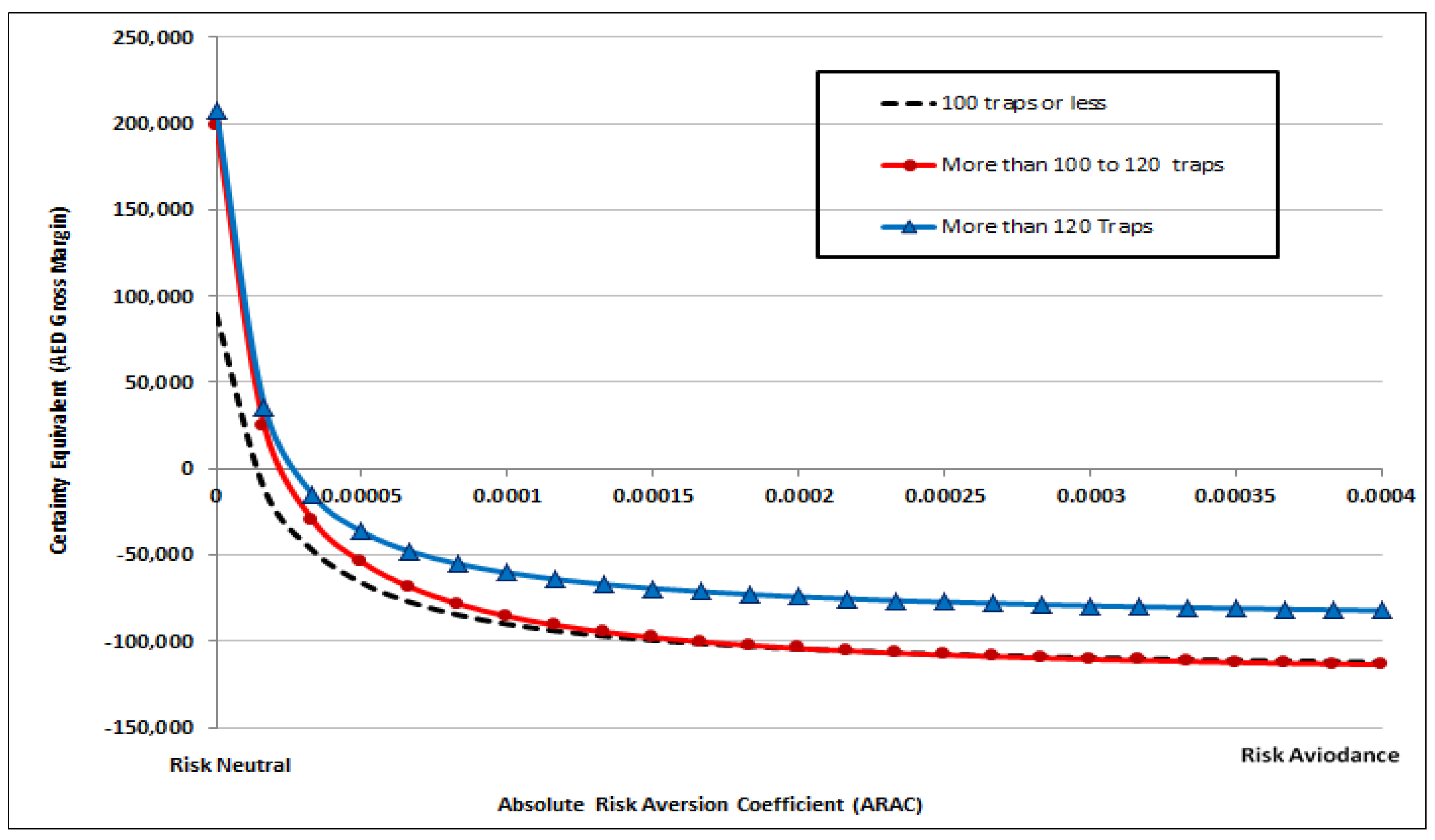Economic Risk and Efficiency Assessment of Fisheries in Abu-Dhabi, United Arab Emirates (UAE): A Stochastic Approach
Abstract
:1. Introduction


2. Methods
2.1. Standard Stochastic Dominance Techniques
 for all values of X. Graphically, this means SSD requires that the curve of the cumulative area under the CDF for a dominant alternative lies everywhere below and to the right of the corresponding curve for the dominated alternative. Although more powerful than FSD, SSD often leaves a large number of choices as being risk-efficient. To improve the discriminating power of SSD, Meyer [29] proposed SDRF, which is a more general notion of stochastic dominance. This rule helps to identify risk-efficient options for the class of decision-makers whose risk aversion coefficients are bounded by lower and upper values. The smaller the range of risk aversion coefficients, the more powerful is the criterion. The SDRF criterion orders the choices by defining intervals using the ra absolute risk aversion coefficients. These risk-preference intervals are bounded by a lower risk aversion coefficient, raL, and an upper risk aversion coefficient, raU, which characterize the general degree of risk aversion for a manger. A risk-efficient set of strategies will include the choices preferred by each manager having risk preferences consistent with the restrictions imposed by the lower to upper interval. Furthermore, Hardaker et al. [30] argued that eliciting decision-makers (or inferring) the bounds on their risk aversion coefficients may be simpler than eliciting a complete utility function. Further discussion of SDRF is provided by Cochran [31], King and Robison [32] and Robison and Barry [24].
for all values of X. Graphically, this means SSD requires that the curve of the cumulative area under the CDF for a dominant alternative lies everywhere below and to the right of the corresponding curve for the dominated alternative. Although more powerful than FSD, SSD often leaves a large number of choices as being risk-efficient. To improve the discriminating power of SSD, Meyer [29] proposed SDRF, which is a more general notion of stochastic dominance. This rule helps to identify risk-efficient options for the class of decision-makers whose risk aversion coefficients are bounded by lower and upper values. The smaller the range of risk aversion coefficients, the more powerful is the criterion. The SDRF criterion orders the choices by defining intervals using the ra absolute risk aversion coefficients. These risk-preference intervals are bounded by a lower risk aversion coefficient, raL, and an upper risk aversion coefficient, raU, which characterize the general degree of risk aversion for a manger. A risk-efficient set of strategies will include the choices preferred by each manager having risk preferences consistent with the restrictions imposed by the lower to upper interval. Furthermore, Hardaker et al. [30] argued that eliciting decision-makers (or inferring) the bounds on their risk aversion coefficients may be simpler than eliciting a complete utility function. Further discussion of SDRF is provided by Cochran [31], King and Robison [32] and Robison and Barry [24].2.2. Stochastic Efficiency with Respect to a Function (SERF)

2.3. Risk Simulation Analyses
2.4. Study Data Source
3. Results and Discussion
3.1. Fisheries Survey Descriptive Statistics
| Variable | Annual total revenue (TR) (AED) | Annual variable costs (VC) (AED) | Annual gross margin (GM) = TR − VC (AED) |
|---|---|---|---|
| Mean | 298,173 | 159,112 | 139,061 |
| Median | 276,000 | 157,680 | 125,320 |
| Standard deviation (SD) | 185,899 | 52,415 | 174,042 |
| Coefficient of variation (SD/mean) | 0.62 | 0.33 | 1.25 |
| Number of observations | 131 | 131 | 131 |
| Statistical measure | Traps | Thread | Nets |
|---|---|---|---|
| Mean | 167,551 | 65,078 | 67,274 |
| Median | 159,360 | 66,430 | 45,280 |
| Standard deviation (SD) | 175,891 | 169,834 | 142,885 |
| Coefficient of variation (SD/mean) | 1.05 | 2.61 | 2.12 |
| Number of observations | 94 | 10 | 27 |
3.2. First Degree Stochastic Dominance (FSD)



| Pairs of fishing management alternatives | K-S test values | D values | Conclusion |
|---|---|---|---|
| Fishing methods | D value is greater than the absolute value of the greatest difference between each pair; cannot conclude the presence of significant difference between the three distributions. | ||
| Traps/Threads | −0.034 | 0.140 | |
| Traps/Nets | 0.041 | ||
| Threads/Nets | 0.074 | ||
| Trap size | D value is less than the absolute value of the greatest difference between each pair; can conclude the presence of significant difference between the three distributions. | ||
| Large/Medium | −0.256 | 0.166 | |
| Large/Small | 0.322 | ||
| Medium/Small | 0.389 | ||
| Number of traps | D value is greater than the absolute value of the greatest difference between each pair; cannot conclude the presence of significant difference between the three distributions. | ||
| Less than 100/100–120 | 0.173 | 0.205 | |
| Less than 100/More than 120 | 0.19 | ||
| 100–120/More than 120 | −0.144 | ||
3.3. Second Degree Stochastic Dominance (SSD)
| Fishing methods | Traps | Threads | Nets | SSD dominance ranking |
|---|---|---|---|---|
| Traps | -- | Dominant | Dominant | 1 |
| Threads | Not Dominant | -- | Not Dominant | 3 |
| Nets | Not Dominant | Dominant | -- | 2 |
| Trap size | Large | Medium | Small | SSD dominance ranking |
| Large | -- | Dominant | Dominant | 1 |
| Medium | Not Dominant | -- | Dominant | 2 |
| Small | Not Dominant | Not Dominant | -- | 3 |
| Number of traps | 100 traps or less | More than 100 to 120 traps | More than 120 traps | SSD dominance ranking |
| 100 traps or less | -- | Not Dominant | Not Dominant | 3 |
| More than 100 to 120 traps | Dominant | -- | Not Dominant | 2 |
| More than 120 Traps | Dominant | Dominant | -- | 1 |
3.4. Stochastic Dominance with Respect to a Function (SDRF)
| Management alternatives | Efficient set ranking with an absolute risk aversion coefficient = 0.0 | Efficient set ranking with an absolute risk aversion coefficient = 0.004 |
|---|---|---|
| Fishing methods | ||
| Thread | Most Preferred | Most Preferred |
| Traps | 2nd Most Preferred | 2nd Most Preferred |
| Nets | 3rd Most Preferred | 3rd Most Preferred |
| Trap size | ||
| Large | Most Preferred | 3rd Most Preferred |
| Medium | 2nd Most Preferred | 2nd Most Preferred |
| Small | 3rd Most Preferred | Most Preferred |
| Number of traps | ||
| More than 120 traps | Most Preferred | Most Preferred |
| More than 100 to 120 traps | 2nd Most Preferred | 2nd Most Preferred |
| 100 traps or less | 3rd Most Preferred | 3rd Most Preferred |
3.5. Stochastic Efficiency with Respect to a Function (SERF)



4. Summary and Conclusions
Author Contribution
Conflicts of Interest
References
- FAO. Information on Fisheries management in the United Arab Emirates. Available online: http://www.fao.org/fi/oldsite/FCP/en/ARE/body.html (accessed on 1 June 2013).
- Ministry of Environment and Water (MOEW). Exploitation, protection and development of the living aquatic resources in the waters of the state of the United Arab Emirates. Available online: http://www.moew.gov.ae/Portal/en/laws-and-legislations/federal-laws.aspx#page=1 (accessed on 15 June 2013).
- Arab Organization for Agricultural Development (AOAD). Arab Agricultural Statistical Database. Available online: http://www.aoad.org/publications.htm (accessed on 25 June 2013).
- Ministry of Environment and Water (MOEW). Stop the new registration of speedy fishing boats. Available online: http://www.moew.gov.ae/Portal/en/laws-and-legislations/executive-by-laws.aspx (accessed on 15 June 2013).
- Abu-Dhabi Environment Agency. Fishers Statisical Bulletin. Available online: https://www.ead.ae/en/portal/fisheries.statistical.bulletin.aspx (accessed on 15 July 2013).
- Kirkley, J.; Paul, C.J.M.; Squires, D. Deterministic and stochastic capacity estimation for fishery capacity reduction. Mar. Resour. Econ. 2004, 19, 271–294. [Google Scholar]
- Sharma, K.R.; Leung, P. Technical efficiency of the longline fishery in Hawaii: An application of a stochastic production frontier. Mar. Resour. Econ. 1999, 13, 259–274. [Google Scholar]
- Pascoe, S.; Coglan, L. The contribution of unmeasurable inputs to fisheries production: An analysis of technical efficiency of fishing vessels in the English Channel. Am. J. Agr. Econ. 2002, 84, 585–597. [Google Scholar] [CrossRef]
- Sherif, S.A.; Gheblawi, M.S. Revenue determinants for Abu-Dhabi fishermen and assessment of input allocative efficiency. Agr. Mar. Sci. 2009, 14, 17–25. [Google Scholar]
- Aisyah, N.; Arumugam, N.; Hussein, M.A.; Latiff, I. Factors affecting the technical efficiency level of inshore fisheries in Kuala Terengganu; Malaysia. Int. J. Agr. Manage. Dev. 2012, 2, 49–56. [Google Scholar] [CrossRef]
- Ahmed, N.; Zander, K.K.; Garnett, S.T. Socioeconomic aspects of rice-fish farming in Bangladesh: Opportunities, challenges and production efficiency. Aust. J. Agr. Resour. Econ. 2011, 55, 199–219. [Google Scholar] [CrossRef]
- Espino, D.C.; Del Hoyo, J.J.G.; Sharp, B.M.H. Capacity and Capacity Utilization of the “Voracera” Fleet in the Strait of Gibraltar. Mar. Resour. Econ. 2005, 20, 367–384. [Google Scholar]
- Singh, R.; Weninger, Q.; Doyle, M. Fisheries management with stock growth uncertainty and costly capital adjustment. J. Environ. Econ. Manage. 2006, 52, 582–599. [Google Scholar] [CrossRef]
- Herrero, I.; Pascoe, S. Value versus volume in the catch of the Spanish South-Atlantic Trawl Fishery. J. Agr. Econ. 2003, 54, 325–341. [Google Scholar] [CrossRef]
- Danielsson, A. Efficiency of catch and effort quotas in the presence of risk. J. Environ. Econ. Manage. 2002, 43, 20–33. [Google Scholar] [CrossRef]
- Bastardie, F.; Nielsen, J.R.; Andersen, B.S.; Eigaard, O.R. Effects of fishing effort allocation scenarios on energy efficiency and profitability: An individual-based model applied to Danish fisheries. Fish. Res. 2010, 106, 501–516. [Google Scholar] [CrossRef]
- Maravelias, C.D.; Tsitsika, E.V. Economic efficiency analysis and fleet capacity assessment in Mediterranean fisheries. Fish. Res. 2008, 93, 5–91. [Google Scholar]
- Andersen, J.L. The inclusion of stocks in multi-species fisheries: The case of Danish Seiners. Mar. Resour. Econ. 2005, 20, 163–184. [Google Scholar]
- Tingley, D.; Pascoe, S.; Coglan, L. Factors affecting technical efficiency in fisheries: Stochastic production frontier versus data envelopment analysis approaches. Fish. Res. 2005, 73, 363–376. [Google Scholar] [CrossRef]
- Del Hoyo, J.J.G.; Espino, D.C.; Toribio, R.J. Determination of technical efficiency of fisheries by stochastic frontier models: A case on the Gulf of Cadiz (Spain). ICES J. Mar. Sci. 2004, 61, 416–421. [Google Scholar] [CrossRef]
- Greenville, J.; Hartmann, J.; Macaulay, T.G. Technical efficiency in input-controlled fisheries: The NSW Ocean Prawn Trawl Fishery. Mar. Resour. Econ. 2006, 21, 159–179. [Google Scholar]
- Robison, L.J.; Barry, P. The Competitive Firm’s Response to Risk; Macmillan Publishing Co.: New York, NY, USA, 1987. [Google Scholar]
- Boggess, W.G.; Ritchie, J.T. Economicandriskanalysisofirrigation decisions in humid regions. J. Prod. Agric. 1988, 1, 116–122. [Google Scholar] [CrossRef]
- Williams, J.R. A stochastic dominance analysis of tillage and crop insurance practices in a semiarid region. Am. J. Agr. Econ. 1988, 70, 112–120. [Google Scholar]
- Williams, J.R.; Llewelyn, R.V.; Mikesell, C.L. An economic risk analysis of conservation tillage systems for wheat, grain sorghum, and soybeans in the Great Plains. J. Soil Wat. Cons. 1989, 34, 234–239. [Google Scholar]
- Greene, W.H. Econometric Analysis, 5th ed.; Prentice-Hall International Inc.: New York, NY, USA, 2003. [Google Scholar]
- Weersink, A.; Walker, M.; Swanton, C.; Shaw, J.E. Economic comparison of alternative tillage systems under risk. Can. J. Agr. Econ. 1992, 40, 199–217. [Google Scholar] [CrossRef]
- Hardaker, J.B.; Richardson, J.W.; Lien, G.; Schumann, K.D. Stochastic efficiency analysis with risk aversion bounds: A simplified approach. Aust. J. Agr. Resour. Econ. 2004, 48, 253–270. [Google Scholar]
- Meyer, J.; Richardson, W.; Schumann, K.D. Stochastic efficiency analysis with risk aversion bounds: A correction. Aust. J. Agr. Resour. Econ. 2009, 53, 521–525. [Google Scholar] [CrossRef]
- Hardaker, J.B.; Huirne, R.B.M.; Anderson, J.R.; Lien, G. Coping with Risk in Agriculture, 2nd ed.; CABI Publishing: Cambridge, MA, USA, 2004. [Google Scholar]
- Cochran, M.J. Stochastic dominance: The state of the art in agricultural economics. In Proceedings of Southern Region Project S-180 Seminar: An Economic Analysis of Risk Management Strategies for Agricultural Production Firms, Tampa, FL, USA, 23–26 March 1986.
- King, P.K.; Robison, L.J. An interval approach to measuring decision maker preferences. Am. J. Agric. Econ. 1981, 63, 510–520. [Google Scholar] [CrossRef]
- Keeney, R.L.; Raiffa, H. Decisions with Multiple Objectives: Preferences and Value Tradeoffs; Wiley Publishers: New York, NY, USA, 1976. [Google Scholar]
- Lien, G.; Stordal, S.; Hardaker, J.B.; Asheim, L.J. Risk aversion and optimal forest replanting: A stochastic efficiency study. Eur. J. Oper. Res. 2007, 181, 1584–1592. [Google Scholar] [CrossRef]
- Pendell, D.L.; Williams, J.R.; Boyles, S.B.; Rice, C.W.; Nelson, R.G. Soil carbon sequestration strategies with alternative tillage and nitrogen sources under risk. Appl. Econ. Perspect. Pol. 2007, 29, 247–256. [Google Scholar]
- Babcock, B.A.; Choi, E.K.; Feinerman, E. Risk and probability premiums for CARA utility functions. J. Agr. Res. Econ. 1993, 18, 17–24. [Google Scholar]
- Richardson, J.W.; Schumann, K.D.; Feldman, P.A. Simulation & Econometrics to Analyze Risk: Simetar© Inc. User Manual; Texas A & M University: College Station, TX, USA, 2008. [Google Scholar]
- United Arab Emirates Ministry of Water and Environment (MOEW). Fisheries Statistics. Available online: http://www.moew.gov.ae/en/knowledge-and-statistics/statistics.aspx#page=1 (accessed on 12 May 2014).
© 2014 by the authors; licensee MDPI, Basel, Switzerland. This article is an open access article distributed under the terms and conditions of the Creative Commons Attribution license (http://creativecommons.org/licenses/by/3.0/).
Share and Cite
Fathelrahman, E.; Basarir, A.; Gheblawi, M.; Sherif, S.; Ascough, J., II. Economic Risk and Efficiency Assessment of Fisheries in Abu-Dhabi, United Arab Emirates (UAE): A Stochastic Approach. Sustainability 2014, 6, 3878-3898. https://doi.org/10.3390/su6063878
Fathelrahman E, Basarir A, Gheblawi M, Sherif S, Ascough J II. Economic Risk and Efficiency Assessment of Fisheries in Abu-Dhabi, United Arab Emirates (UAE): A Stochastic Approach. Sustainability. 2014; 6(6):3878-3898. https://doi.org/10.3390/su6063878
Chicago/Turabian StyleFathelrahman, Eihab, Aydin Basarir, Mohamed Gheblawi, Sherin Sherif, and James Ascough, II. 2014. "Economic Risk and Efficiency Assessment of Fisheries in Abu-Dhabi, United Arab Emirates (UAE): A Stochastic Approach" Sustainability 6, no. 6: 3878-3898. https://doi.org/10.3390/su6063878
APA StyleFathelrahman, E., Basarir, A., Gheblawi, M., Sherif, S., & Ascough, J., II. (2014). Economic Risk and Efficiency Assessment of Fisheries in Abu-Dhabi, United Arab Emirates (UAE): A Stochastic Approach. Sustainability, 6(6), 3878-3898. https://doi.org/10.3390/su6063878





